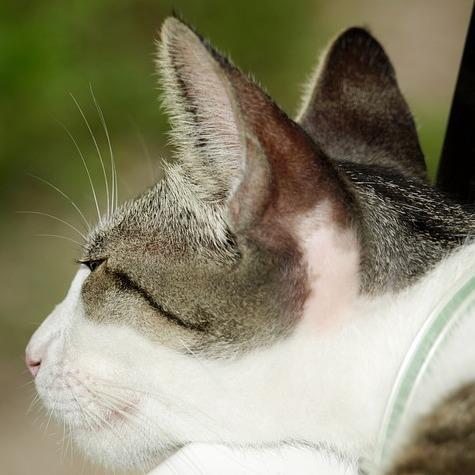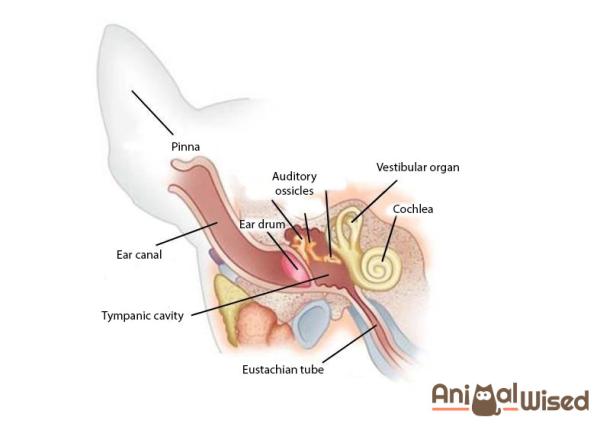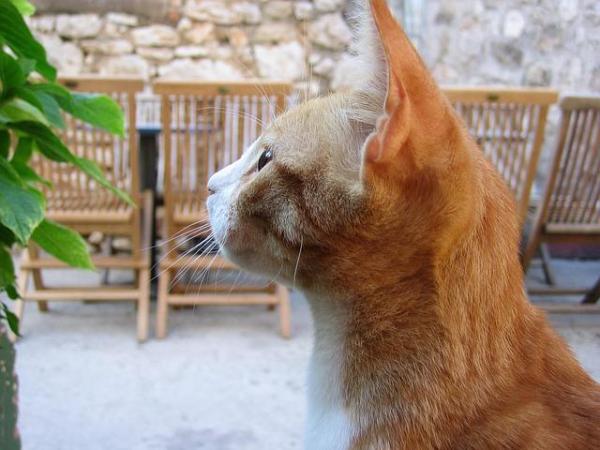
Do you think that your cat may have otitis? Are you sure how otitis may have appeared in the your faithful companion's ears? What are the symptoms, what does it mean and can it lead to further consequences?
If you are interested in knowing everything to do with otitis in cats, carefully read this AnimalWised article and help your pet recover from this condition.
What is otitis?
Otitis is inflammation of the epithelium lining of the ear canal and pinna. This inflammation often causes pain and temporary hearing loss among other things. It is also accompanied by many other symptoms that make it more easily identifiable and that we'll explain later.
This ear problem usually occurs often when cats have low immunologic defenses. It is proven that the times of the year in which most otitis cases occur in cats are spring and summer due to the increase of the temperature and humidity of the environment. The spread of some possible causes of otitis such as ear mites, occurs through direct contact with infested animals or a certain area of their body. In shelters, in farms, in areas where there are controlled cat colonies and in general in any area where many cats live, this contagion occurs most often through direct contact, thus the constant control of all and every aspect of their health is always very difficult. Otitis can also occur without contagion, i.e. occurring due to secondary trauma or bacterial or fungal infection due to a foreign body, among other causes.
There are different types of otitis according to its cause, and the area of the ear which it affects. According to the affected area they can be classified into:
- Otitis externa: It's the most common type of otitis, but it is the least serious and the easiest to treat. It affects the outer ear, namely the ear canal from the ear to the eardrum. If this otitis is very severe, the pinna is very affected and can perforate the eardrum, thus spreading inflammation and the condition to ear medium, causing a secondary otitis media.
- Otitis media: This otitis usually occurs most commonly when a otitis externa has been ineffectively treated. It occurs in the middle ear area, where we find the eardrum that has inflamed and even broken due to otitis.
- Otitis interna: It is the inflammation of the inner ear and is usually produced by trauma or a poorly healed otitis externa or media. Due to its depth in the ear it becomes more complex to cure.

Are certain cats more prone to otitis than others?
First of all we should say that, generally, cats are less prone to otitis than dogs. But in reality anyone can suffer from otitis and within domestic cats we find that those who are more prone to this condition are those between one and two years of age.
In addition, long-haired cats, as they usually have a lot of hair in the ears, also have higher risk of developing otitis, since ear hairs carry more dirt and moisture. Cats that are in the open air for a long time have a higher risk of ear related diseases, including otitis, so it is very important to get a periodic review of their auditory canals. Cats with very low defenses due to another main condition are also very prone to this ear condition.

What are the causes of otitis?
Otitis can be caused by different things such as foreign object lodged in the ear canal, bacteria, fungi (yeast), external parasites such as mites and trauma in the area.
Below, we'll explain a few causes of otitis in cats:
- Ectoparasites: Ectoparasites that produce the most common feline otitis are mites, microscopic external parasites that, when they appear in large numbers in an area may be viewed directly. This mite is called Cynotis otodectes and is not only housed in the ear when it infests an animal, but is also found on the skin, especially the head and neck.
- Bacteria and fungi (yeast infection): They are opportunistic pathogens that cause a secondary otitis. These take advantage of situations such as excess moisture, residual water after a bath that can stay in the ear, the presence of foreign bodies, trauma, allergies and irritations caused by cleaning products for ears that are unsuitable for cats. The most common bacteria are Pasteurella multocida, Pseudomonas aeruginosa, Proteus, and e. coli. In the case of fungi, the most common is Malassezia.
- Foreign bodies: Sometimes, especially in the case of cats that spend a long time outside, certain object such as leaves, twigs and stems may enter the ear canal and become a foreign body lodged in our cat's ear. This object lodged in the ear canal will bother the animal and will therefore try to remove it, usually without success, and finally end up damaging and inflaming the ear and producing bacterial secondary otitis or opportunistic fungi. We must avoid extract ourselves the foreign body and let do it a veterinarian with suitable material. This case of otitis in cats is less frequent than in dogs.
- Trauma: As we have said before, another reason that can cause secondary otitis in our fellow cat's ears are injuries, i.e., a blow which has produced damage internally and from this inflammation and injuries, bacteria and fungi take advantage and provoke otitis.
Other diseases and problems that promote secondary otitis: Secondary otitis usually occurs more commonly due to the previously mentioned, but can also arise from other diseases that the feline is already suffering from and therefore can be a symptom of it. For example:
- Inherited problem of keratinization: It is a defect in the keratinization which is inherited. This problem in the process of the keratinization causes inflammation and seborrhea and easily makes ceruminous and erythematous secondary otitis arise. In the case of further complications, it can lead to secondary purulent otitis. Cases of hereditary disease tend to occur more frequently in Persian cats.
- Atopy and food allergy: This type of allergy is more common in dogs but is also seen in domestic cats. They can produce secondary otitis, especially when these allergic processes have previously caused facial dermatosis. In this case, it tends to be caused by opportunistic organisms of various types of bacteria, but also by the yeast (fungus) called Malassezia pachydermis.
- Hypersensitivity by contact and irritant reaction: Cats are generally very sensitive to products and medicines, but above all, to certain cleaning products such as ear drops. These products often produce them severe irritation in the ear canal giving way to secondary otitis. We must never use these products that are not indicated for use in cats and preferably use one recommended by our vet.
- Immune diseases: This type of diseases are associated with headphone injuries and external otitis. Due to excessively low defenses which cause these diseases in our pets, bacteria and fungi have the opportunity to proliferate and give a cat secondary external otitis easily. We must keep FIV or feline immunodeficiency virus in mind.
- Tumors: There are cases in older cats which otitis is recurrent and even chronic, in this case we should suspect of a tumor, either benign or malignant, ancillary structures of the ear. For example, white ear squamous cell carcinomas are common.
- Nasopharyngeal polyps: They are non-malignant proliferations, i.e. which are not abnormal. Therefore, it is common for young cats to have these polyps detected in the middle ear, ear canal and nasopharyngeal mucosa areas. Along with foreign bodies, these polyps are the most common cause of unilateral external otitis in cats. In this case the otitis is usually resistant to the medication and it can even cause an otitis media with respiratory signs.
- More diseases and problems that can cause otitis: Scabies, seborrhea, metabolic, endocrine and nutritional disorders.

What are the symptoms of otitis in cats?
The signs and symptoms that your cat will present if they have otitis depend and will vary especially according to their degree of intensity and of the original cause of otitis. The symptoms that we will recognize are:
- Frequent head-shake.
- Head tilt. If only given to one side, this indicates unilateral otitis that tends to be caused by the presence of a foreign body in the ear. In case of trouble the two ears will be alternating the side according to which bothers them more than the other.
- Pain in the area when we pet them. They tend to complain and Meow very much and even crying because of the pain.
- Itching can range from moderate to severe.
- Because the itch is scratched and the ears and neck rubbed very often, it can cause injury in the area.
- Reddened and swollen ears and surrounding area.
- Irritation, exudation and pyoderma of the affected area.
- Bad mood and even aggression, zero desire to play and can occasionally even stop eating because of great discomfort and pain that may be having.
- Abundant dark wax in the ears.
- Hearing loss.
- Bad smell in their ears.
- Hair loss in the affected areas due to the excessive scratching produced by itching.
- Presence of ear mites. In case of a very severe infestation of mites, you must take into account that it may be a case of low defenses due to VIF (feline immunodeficiency virus).
- Otohematoma: A problem derived from the excessive scratching and continuous shaking of the head. Otohematomas are blood buildup in the ear and appear on the concave surface of it, between the skin and cartilage, when blood capillaries break. Externally we can see it as a ball in the ear, that really bothers the animal and is very hot. The only solution is surgery.
It is of vital importance for our pet's well-being to go to the vet as soon as we identify any of the symptoms mentioned above so your cat can be properly diagnosed and treated.

How can we prevent and treat otitis?
We will then give you a few tips and remedies to prevent and treat otitis in cats:
- Keep track of their health from home: It is vital that, periodically, whenever we brush and bathe our pets we check on various parts of their body including the ears. If we detect any symptom described above we must go to the vet as soon as possible without a doubt and avoid pain, discomfort and complications for our friends.
- Prevent dirty ears: When we groom our cats we must check for dirt that may enter their ears. If you see that they need to be cleaned due to built up wax, which is usually necessary every two or three weeks, we will never use the cotton sticks we usually use on ourselves. You should know that you can harm their inner ear with a stick due to a sudden movement, which can even break the eardrum. So, the best way to clean the ear is with a sterilized gauze wrapped around our finger and moistened in saline solution and gently remove the dirt only in the area of the pinna, that is to say, only the dirt from the area that we see and can reach.
There are drops or ear cleaners available, but due to the fact that cats are very sensitive to medications and products in general, whether chemical or natural, we must always use one which is specifically prescribed by our trusted vet and never one that we see in a pet shop and think it's OK to use. Above all, we must never use a product for dogs unless indicated expressly for cats, since this type of substances that cause irritation are also an important cause of otitis in our cats. In addition,in the case of long-haired cats, we can ask the vet to occasionally cut the hairs in their ears to prevent the accumulation of dirt.
- Prevent getting their ears wet: When we bathe them we must prevent SOAP and water. An easy way is with cotton disks dipped in a bit of Vaseline, spread within the ears gently so that we can remove it easily. It is very important to remember to remove these disks because if we leave them there they will bother our pet, but also, if you are unable to remove them by yourself, they will prove to be a foreign body lodged in the ear, and can end up producing otitis. To remove any residue of Vaseline, cotton or if there is water, use a sterile gauze wrapped around a finger to remove and dry. It is very important that water does not enter the ear or it is pressurized to prevent breakage of the eardrum, but if the ear is also moistened we must make sure we leave the area dry and clean.
- Periodic veterinary review: Whenever the vet visit them, either for routine or something more specific, they must check the status of their ears more aggressively than how we can do it at home. In this way we will avoid that, if your cat has otitis, things get more serious than they already are.
- Follow the treatment indicated by the veterinarian: if your cat is suffering from otitis, the veterinarian will offer us a treatment to follow which will be very important to follow thoroughly and, even if it seems like the problem has been solved, we must follow the treatment until the end. Treatment depends on the type of otitis that they have, it but mainly be:
- First remove the foreign body if any.
- Perform cleaning and drying of the ear.
- Make sure you know the cause to apply appropriate treatment:
- Foreign body: The veterinarian must remove the foreign body in order to perform the cures for otitis. Once the foreign body is extracted, you will give them topic drugs ear cures that our vet will have prescribed and we will apply them as explained to us.
- Bacteria: Cleaning with water or physiological saline solution should be performed so that the specialist can check all the ear canal better. In case of a bacterial otitis he/she will prescribe a topical product and ear antibacterial.
- Fungi (yeast): In this case, once the veterinary expert has determined that fungi are the cause, he/she will prescribe an appropriate fungicide product.
- Ectoparasites: Mites are ectoparasites that cause the most common otitis. The veterinarian will prescribe us a de-wormer in the form of a pipette to distribute in the area spread around the area and an otic acaricide product. Anti-inflammatory medications to reduce the swelling and pain caused by otitis will also be prescribed.
When the above does not take effect or only if the veterinarian considers that it is the only solution, there will be surgery.
We must know that when any type of ear drops are applied to an animal, they then will shake their head to eject them from the inside of their which is rather annoying. But it is very important to continue with the treatment and let them shake their head to remove dirt more easily. In addition, even though the otitis has apparently been cured, we must finish the treatment as directed by the specialist and make it last as long as they have told us. It is very important to lengthen the treatment one week more after it has apparently healed the otitis, to make sure that otitis will not reappear easily
- The Elizabethan collar: Surely, the veterinarian will provide us with one of these, as support treatment that we will have to place on our pet's collar or neck, this collar may seem like a nuisance for them but they will eventually become used to it. Remember it is very important for them to wear it, since it will prevent them from scratching uncontrollably and creating any more injuries and even avoiding unwanted otohematomas.

This article is purely informative. AnimalWised does not have the authority to prescribe any veterinary treatment or create a diagnosis. We invite you to take your pet to the veterinarian if they are suffering from any condition or pain.
If you want to read similar articles to Otitis in Cats, we recommend you visit our Other health problems category.